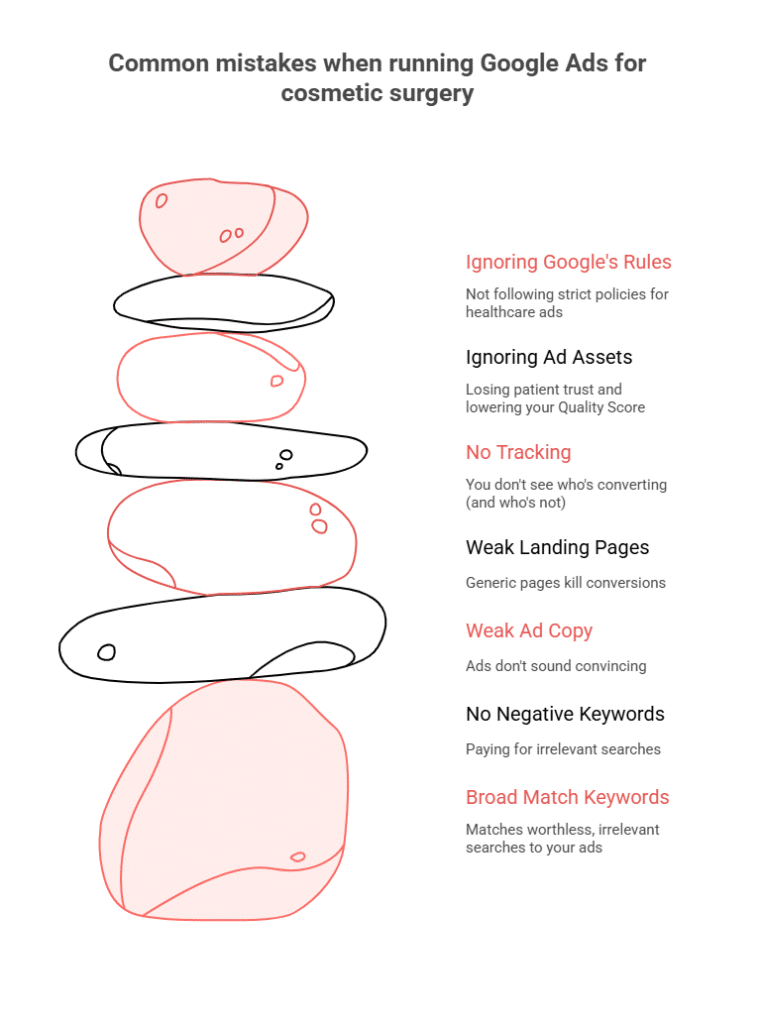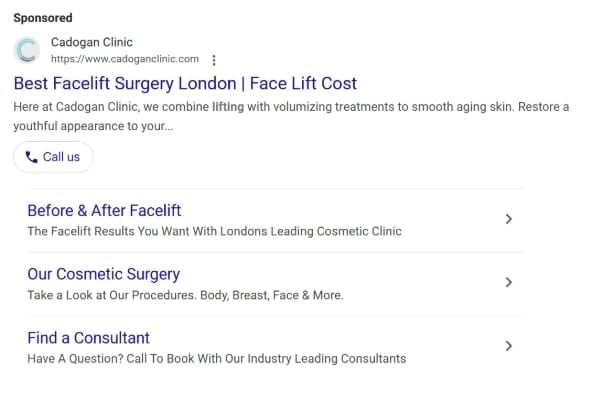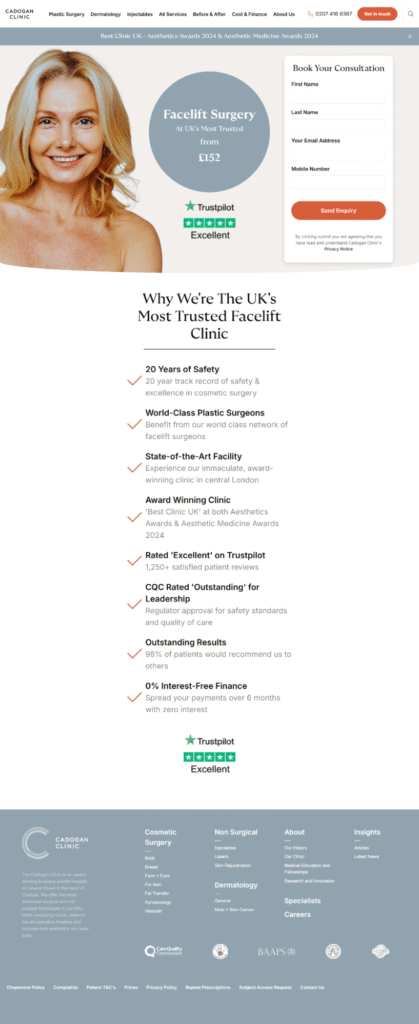Google Ads for Cosmetic Surgeons

Last Updated on: 12th September 2025, 11:06 am
Cosmetic surgery is one of the most competitive niches in Google Ads. Just look at the demand!
In comparison to 10 or 20 years ago, half the US population is Googling facelifts, and the number of cosmetic procedures grew by 5% in the U.S. alone between 2022 and 2023.
“Claire, how do I claim some of this demand for my own practice?”
Follow me as I break down my 17+ years of experience to help you run profitable ads!
How Much Should You Spend on Google Ads for Cosmetic Surgery?
A single booked consultation can turn into a procedure worth thousands.
I regularly see surgeons paying $18 – $25 per click in competitive markets. And if those clicks are coming from qualified patients because of strong Google Ads targeting, that’s phenomenal.
But if it’s coming from time-wasters, we need to talk.
Additionally, remember that the right budget for your cosmetic surgery Google Ads depends on factors like:
- Where you’re located
- Which procedures you focus on
- How aggressively your competitors are bidding
If you’re in London targeting “liposuction,” you’ll need a very different budget than a clinic in a smaller city.
By the way: bigger spend doesn’t mean bigger efficiency.
I’ve audited accounts spending $10,000+ per month with little to show for it because the agency spent money on broad match keywords like “plastic surgery” and let Google’s automation display ads to people who never wanted a procedure in the first place.
On the other hand, I’ve worked with surgeons who consistently booked consultations because their campaigns were set up properly:
- Every keyword was tightly controlled
- Landing pages were optimised
- Negative keywords were in place
So here’s how I advise you to think about budgeting for your cosmetic surgery Google Ads:
- Work backwards from the cost per consultation. If you’re comfortable spending $250 to book a patient for a $6,000 procedure, that’s your baseline.
- Factor in your market. You don’t need to outspend the big clinics; you only need enough to be consistently visible to qualified patients.
- Test, then scale. Start smaller. Once you get consultations and data, you’ll know how to scale properly.
Does Your Google Ads Account Have These Issues?
Over seventeen years into Google Ads, I can tell you the same mistakes show up in almost every cosmetic surgeon’s Google Ads audit.
- Broad match keywords everywhere. Agencies love them because they visually increase traffic reports. However, broad match keywords will match you to worthless searches like “free cosmetic surgery” or “DIY lip fillers.”
- No negative keywords. Without negative keywords, you’ll pay for clicks from people searching “cosmetic surgeon jobs” or “salary of a cosmetic surgeon.” None of these people will ever become patients.
- Weak ad copy. Too many ads sound generic when patients want reassurance that they’re in safe hands.
- Weak landing pages. Sending people to a generic homepage is a guaranteed conversion killer. If someone searches for “rhinoplasty consultation,” they expect a landing page about rhinoplasty, not a menu of twelve other procedures.
- No tracking. This one’s the most dangerous. If you don’t have conversion tracking set up, you can’t see which $200 click turned into a booked consultation.
- Ignoring Google’s ad assets. Call extensions, location assets, structured snippets…those all convince a qualified patient that they can trust your practice. They also affect your ad’s Quality Score, which, in turn, affects your Cost Per Click.
- Ignoring Google’s rules. Google has strict policies around what you can and can’t say. As I recently discussed in my case studies for another medical niche, it’s key to have a partner who can help you navigate these challenges.
How to Set up a Strong Google Ads Campaign for Cosmetic Surgery
Step 1. Pick the Right Campaign Type
Google gives you several options: Display, Performance Max, Demand Gen… and yes, they all have their place. But the strongest type to start with is: Search.
Here’s why I insist surgeons start there:
- Search = intent. Someone typing “blepharoplasty consultation London” is light years closer to booking than someone who sees a banner while reading the Daily Mail. Search tells you what they want in their own words.
- Display = distraction. Banners on random sites rack up impressions but rarely lead to the phone ringing. You don’t need awareness; you need appointments.
- Performance Max = long-term play. Yes, it mixes Search with video, Display, and Gmail. But only Search brings you to users when they’re at their most convinced about getting a procedure. Gmail and Display meet them when they’re still unaware.
To be fair, PMax has come a long way in 2025. In the skilled hands of a Google Ads consultant, it can open doors to audiences you’d never considered. But if you’re a surgeon just getting started with ads, PMax shouldn’t be your first step.
Search campaigns are controlled, measurable, and tied directly to intent. When you want to start seeing results from your Google Ads budget quickly, choose Search.
Step 2. Selecting Keywords for Your Cosmetic Surgery Google Ads
Google’s algorithms are good, but they’re also guilty of deciding that, for example, “rhinoplasty consultation” belongs in the same campaign as “tummy tuck reviews.”
Those are different procedures, different intent, different patients entirely. You – or your Google Ads management consultant – need to control the keywords.
Here’s how I coach clients through selecting the right keywords for their cosmetic surgery Google Ads:
- Start with a keyword sheet. Group them by intent: consultation, research, post-op, etc.
- Build ad groups around those clusters so that spend and relevance are controlled.
- If one procedure pulls heavy search traffic, give it a standalone campaign.
- Smaller-volume terms can share, but only if the intent is identical.
All the while, I prefer to avoid broad match, so we retain control over the keywords that make sense for your practice.
Step 3. Write Ad Copy that Resonates with Qualified Patients
Your copy needs to filter out the wrong people as much as it attracts the right ones. That means:
- Lead with intent. If someone searched “facelift consultation Boston,” they don’t want vague lines like “Book your appointment today.” They want to see the exact procedure and location reflected back at them.
- Be specific, not generic. Highlight surgeon credentials, safety signals, or unique angles (like “20 years performing rhinoplasty in Dallas”) instead of generic benefits.
- Think benefits, then back it up. Patients couldn’t care less about “state-of-the-art equipment”. They want to know what that means for them (safer, faster recovery, natural results).
Treat ad copy like a triage process: speak to the patient you want, disqualify the one you don’t, and make the next step obvious.
Here’s a stellar example of Google Ads copy for cosmetic surgeons:
That ad is a solid example of copy for cosmetic surgeons because it does three things right:
- Good ad copy for Google Ads for cosmetic surgery leads with intent. The headline hits the exact search term I searched for (“facelift surgery London”) while also nodding to cost, which is usually the next thing on a prospect’s mind.
- It backs it up with assets. Sitelinks like Before & After Facelift and Find a Consultant give searchers extra routes to click. That filters casual interest from people who are closer to making a decision.
- It signals trust. The language “London’s Leading Cosmetic Clinic” and the call button asset tell patients: “This isn’t a faceless ad; there are real consultants waiting for you, and you can reach them with one tap.”
In other words, it does what great ad copy should: mirror the searcher’s intent, offer clear next steps, and stack the trust signals right where people are about to click.
Key compliance rules in Google Ads for cosmetic surgery
From my own experience with healthcare Google Ads:
- You can’t use trademarked terms (think Botox) in ad copy.
- Landing pages get scrutinised for exaggerated claims, misleading text, or even certain before/after imagery.
- Some procedures or treatments may require pre-approval or certification before Google lets your ads run.
- Targeting options are more limited. Remarketing lists, for example, are often restricted in the healthcare industry.
- Regulations differ from country to country. What works in the US may not even get approved in the UK.
Learn more about how I help you navigate rules and regulations for healthcare ads in this case study.
Step 4. Use Vital Ad Assets
Many surgeon account ads have a headline, copy and then… nothing. No sitelinks, no call button, no location. That’s just a very expensive blue link.
Ad Assets are free, and they’re your chance to make an ad look like it belongs at the top of the page:
- Location assets: Show your clinic address and map. If someone’s ready to book, don’t make them hunt through your website for directions.
- Call assets: If they’re on mobile, they want to tap a number immediately, not try to find it from your site.
- Sitelinks: Link straight to the key information, like consultations, financing options, and before/after galleries.
- Callouts + structured snippets: Your credentials, safety record, recovery times – the points that set you apart when someone’s comparing two providers side by side.
- Price or promo assets: If you offer consultation specials or transparent pricing, mention it. It filters out the time-wasters who just want “How much does a nose job cost?” clicks.
No, you don’t need every single asset. However, you need the ones that matter to your patients, so make sure every asset has its place.
Step 5. Dedicated Landing Pages for Cosmetic Surgeons
If your ad promises “Book a consultation for breast augmentation,” don’t point people to a generic “Our Services” page with twelve different procedures.
A strong landing page should:
- Match the intent of the ad. If you promised a breast augmentation consultation, the page headline should speak directly to that. It doesn’t have to be word-for-word, but the message has to line up so patients know they’re in the right place.
- Put the booking action above the fold: form, phone, or both.
- Reinforce trust with before/after results, surgeon credentials, and safety information.
Here’s a stellar example of a landing page done right:
If you clicked that same London facelift ad, you’d land here:
Immediately, the page clears three big hurdles that so many cosmetic surgery campaigns struggle with:
- Ease of contact. The consultation form is above the fold, clean, and impossible to miss. Name, email, phone…that’s it. The “Call us” and “Get Started” buttons at the top mirror this for people who want to pick up the phone or choose another route instead.
- Price transparency. “From £152” is front and centre. Even if patients know surgery will cost much more, a ballpark figure gives reassurance that they’re not wasting their time.
- The right imagery. That smiling, mature woman is intentional. Prospective facelift patients want to see themselves reflected, not a 23-year-old influencer.
- Confidence boosters everywhere. Trustpilot stars, “20 years of safety,” world-class surgeons, and an award-winning clinic. Every doubt a prospective patient has is answered in the bullet list. From regulatory approval to financing options, the clinic has stacked proof, so the visitor has no excuse to leave the page.
- No distractions. The page doesn’t wander off into blog articles or every other service. It’s focused on facelifts, from headline to form. That clarity is what converts.
Step 6. Properly Targeting the Right Leads
Geography isn’t optional in this niche. If your clinic’s in Manchester, why would you be paying for clicks from Birmingham?
1. Pick the right level of geo targeting
- If you only serve patients locally, don’t target the whole country – start with your city or region.
- If you have multiple branches, give each one its own campaign so budget and reporting stay clean.
- Exclude areas that bring in clicks but never book. If clicks from a neighbouring city convert badly, cut them off.
2. Layer in demographics
- Age. Don’t pay to show facelift ads to people in their twenties. Set age brackets that make sense for each procedure.
- Gender. Relevant for surgeries like gynecomastia or breast augmentation.
- Household income. Elective surgery isn’t a low-cost decision. Use Google’s income tiers to avoid spending on people who were never candidates.
3. Optimise your Google Ads for cosmetic surgery continuously
- Run a geographic performance report in Google Ads. See which postcodes or regions drive consultations and which waste your budget.
- Shift more budget into your top-performing areas, and reduce bids where you’re seeing weak ROI.
- Create location-specific ads or landing pages where it makes sense. A patient searching “rhinoplasty New York” should land on a New York-focused page, not a generic “cosmetic surgery” page.
Step 7. Set up Conversion Tracking (Non-Negotiable!)
Knowing that the phone is ringing is fine, but after it rings two or three hundred times, it will be hard to keep track of patients who booked the most lucrative procedures. And those procedures are the ones you want to target with your Google Ads.
Configure your tracking early. At minimum:
- Install the Google tag site-wide (the new global tag).
- Track calls, form fills, and confirmed consultations as conversions.
- Test it.
Only then can you start scaling.
Step 8. Opt for Manual Bidding Until Your Data Is Clean
Google often lets Smart Bidding loose on day one. Don’t let it. Automation only works if it has clean conversion data – otherwise, it’s just scaling the wrong signals faster.
Here’s how I frame it:
- Manual CPC (start here). You or your Google Ads coach control bids while you test keywords, ads, and landing pages.
- Target CPA or ROAS (later). Once you have 30 to 50 real conversions a month, automation becomes useful.
Don’t chase impressions, by the way. We’re not talking about brand awareness; we’re talking about the right leads walking through the door. Focus on conversions.
Why You Should Work with a Consultancy – Not an Agency
I spoke about this on LinkedIn a few months ago: Most agencies are built for scale, not precision.
I’ve seen the same copy-paste “strategy” dropped into accounts for cosmetic dentists, gyms, e-commerce stores…and then handed to surgeons as if the stakes are the same.
They aren’t.
Because they don’t understand the nuance of medical advertising, they lean on automation. The line is always, “Google’s algorithm will optimise over time.”
What they don’t admit is that you’re paying for that “learning period” out of your own budget.
If you’re watching your spend tick along with no lift in consultations, that’s not a mystery. That’s the algorithm using your money to educate itself while patients go to competitors who built their accounts properly from day one.
To put it bluntly, conversion-focused PPC requires care that most agencies don’t have the patience or experience to deliver.
In contrast, a PPC consultancy with a track record in working with cosmetic surgeons understands:
- The rules and regulations
- The competitive landscape
- Potential hurdles
- And your main competitive differentiators
That way, you start seeing real results faster while continuously working with the people you’ve originally spoken to. In my consultancy’s case, that’d be me and my 17+ years of Google Ads experience – not a junior member that agencies hand you off to.
Claire and her team stepped in on an account we’d been struggling to make progress on with our previous vendor. Finishing the year negative in 2024 prompted us to make the change and we couldn’t be happier with the results.
Patrick Mceuen (Trustpilot)
Claire’s team communicates really well and lets you chime in yourself to direct strategy elements while keeping you from hurting yourself. Arming them with the right data and insights allows them to provide the results you’re looking for, you just have to meet them halfway.
We’ve 8x our totals from a year ago YTD in a vertical that’s highly competitive. The results speak for themselves.
A Better Way Forward
Google Ads can work phenomenally for cosmetic surgeons. However, that only happens when accounts are built properly.
That means:
- Keywords that reflect booking intent.
- Ads matched with relevant landing pages.
- Tight geographic and demographic targeting.
- Relentless focus on tracking real consultations, not vanity clicks.
When those pieces are in place, you know which campaigns are producing patients and which aren’t worth your money.
I’ve been running and teaching Google Ads since 2008, helping thousands of business owners make the most out of every campaign.
If you’d like the same, get in touch.
Want to do it yourself? My best-selling book, Rapid Google Ads Success, gives you the 7 steps to make your first campaign profitable, fast.





